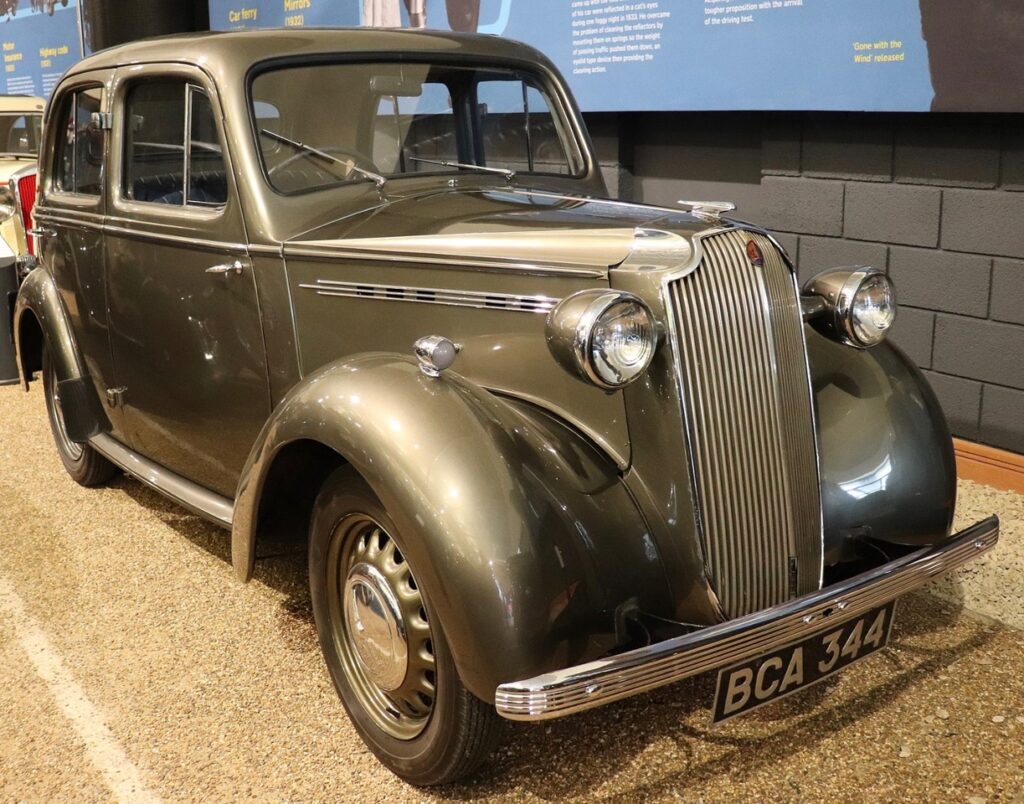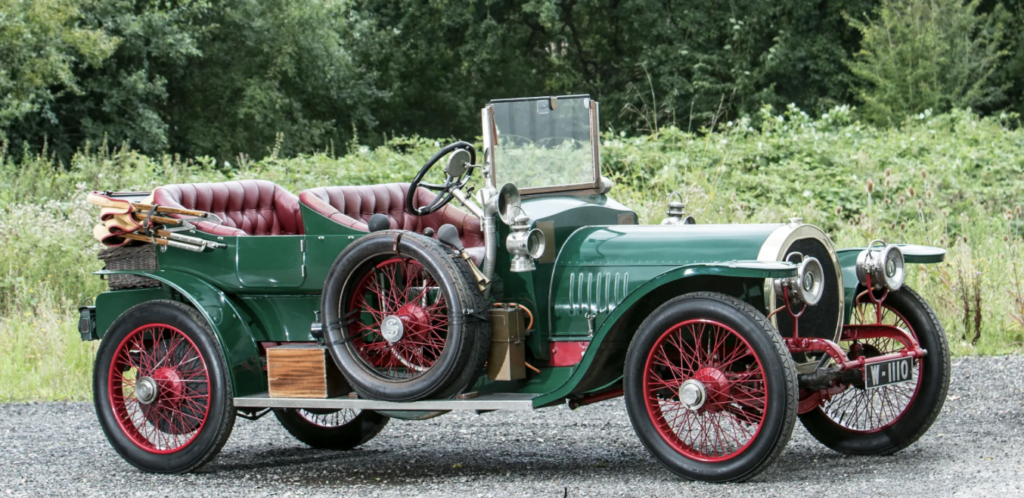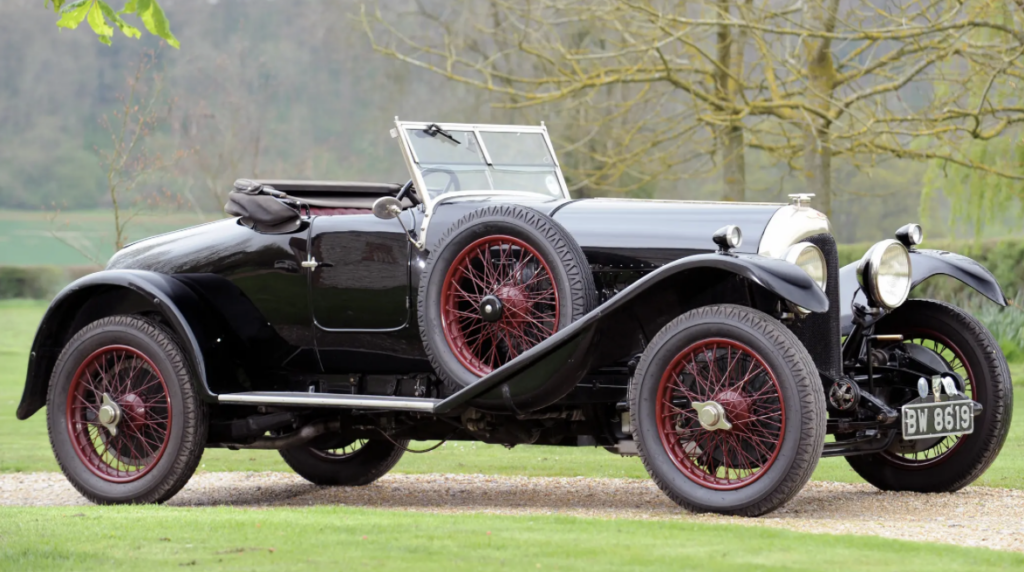Paul Adey, a retired company director in the motor industry, continued with his hugely informative talk from last year.
Vauxhall Motors was a gem of a name, unlike some of its cars. The story goes that King John granted lands in the 13th century to Fulk le Breant. His seat along the Thames was Fulk’s Hall, eventually morphing into the name Vauxhall, where its first five horsepower £136 car was made by Alexander Wilson at the Vauxhall Iron Works. Had it had a reverse gear it might have been a bit more. That soon happened and the company relocated to Luton.
In 1911, Vauxhall went upmarket to produce the Prince Henry, the first true British sports car. In 1937 they introduced the 10-4, the first mass-produced British unibody saloon (fig 1, identical to the blog writer’s own student car, on the left *). General Motors took over both Vauxhall and Opel. The company’s reputation suffered after its introduction of mid-market mass-produced saloons. After a more recent French takeover, the current generation of Vauxhalls are better quality, some with boy racer appeal.
The Sheffield Simplex, our own city’s iconic car (fig 2, below *) was produced between 1907 and 1920 and financed by Earl Fitzwilliam of Wentworth Woodhouse. It was a silent high-quality car. Only three models remain; one in Kelham Island Museum. Local industrialist Lord Riverdale had one which he took from Land’s End to John o’ Groats in top gear all the way.
Henry Royce, a railway engineer, joined forces with Hon C.S. Rolls, an aristocrat in the Brooklands set. Rolls-Royce was born in 1906 and the Silver Ghost launched the following year. Rolls died in a flying accident in 1910. Rolls Royce acquired Bentley in 1931. Walter Owen Bentley was an engineer in Doncaster who had designed the Sopwith Camel, but tricky to turn because of centrifugal forces generated by its refined but excessively heavy engine.
Bentley’s first car was produced in 1919. The Bentley Boys were wealthy petrol heads who raced Le Mans and their success contributed much to Bentley’ s reputation. After the Le Mans win in 1924, the Bentley 3L Sport (fig 3, below *) was the one to have if you were rich and famous.
Before WWII, a Bentley was a sporty version of the Roller. In 2003 VW took over production from Vickers who held onto the Rolls-Royce name, subsequently acquired by BMW. Today, Bentleys are better cars than BMW-owned Rolls-Royces. Of all Bentleys built, an amazing 89 per cent survive today due to their high build quality.
The blog writer at this point in the lecture developed an acute episode of sinking paranoia about his own prognosis, put his phone camera away and felt better after a beer.
“Colonel” John Davenport Siddeley, of Armstrong Siddeley, was never actually in the army. He started Siddeley Autocars in 1902 using Peugeot mechanics and his own car bodies. He was acutely aware that a good product needed good publicity. He’d already set up the Clipper Tyre company and completed Land’s End to John o’ Groats to great acclaim without getting a puncture. In 1905 he amalgamated with Wolseley, but after the latter dropped the Siddeley name, he joined forces with Deasy, who had an aura for quality, adding his name to make Siddeley-Deasy cars in 1912. In 1919 after WWI the company turned its attention to aviation and was renamed Armstrong-Siddeley.
In 1913, Robert Bamford and Lionel Martin, the founders of Aston Martin, were retailing the Singer 10 but had already made their own car by 1915, although WWI stopped its production. By 1922 they had a car ready for the French Grand Prix and were breaking records at Brooklands. But bankruptcy followed in 1924. Bamford had already left, and Martin sold the company. Renwick and Bertelli, prominent in the racing scene, capitalised on the Aston Martin name, but also ran into financial trouble in 1932. After its rescue, Aston Martin International concentrated on road cars up to WWII, when it turned to armaments. David Brown, also acquiring Lagonda, turned Aston Martin around to produce the famous DB series. Ford subsequently had a controlling stake by 1993 and a partnership with Mercedes was established in 2013.
William Rootes founded the eponymous company in 1913. Initially concentrating on repair of aero engines, he took over his father’s motor business. Car production resumed after WW1. By 1930 Rootes was the largest truck and car distributer in the UK from his showrooms at Devonshire House, Piccadilly.
The mid-range Humber Snipe and the small Hillman Minx were their bread and butter during the 1930s. The Minx was the designated RAF staff car. Monty’s car during WWII was a Humber. Rootes moved to Coventry in 1940, concentrating on armaments during the war. They bought Singer in 1956; the Singer football team eventually became Coventry City FC.
The 1960s saw badge engineering at its best. Strikes in 1961 resulted in more than 50,000 cars lost from stoppages. The introduction of the Mini by BMC in 1959 significantly dented Rootes’ launch of its own mini, the Hillman Imp, which faced a very difficult market. Engine blocks cast in Linwood (Scotland) were sent to Coventry for machining, then back to Linwood for assembly, a costly and wasteful exercise. The company was sold to Chrysler for just £1 in 1967.
There are only three British manufacturers now British-owned (AC, Alvis and Ginetta), an abject failure in view of the UK’s record in pioneering motor engineering. The reasons can be summed up simply as a British superiority complex regarding its overseas competitors, import taxes, poor management, inter-company rivalry and poor co-operation, poor working relations, strikes, and poor understanding about the direction of research and development.
Conversely, British Motorsport has a huge number of employees generating billions of pounds. So maybe all isn’t lost.
* All images courtesy of Wikipedia.



